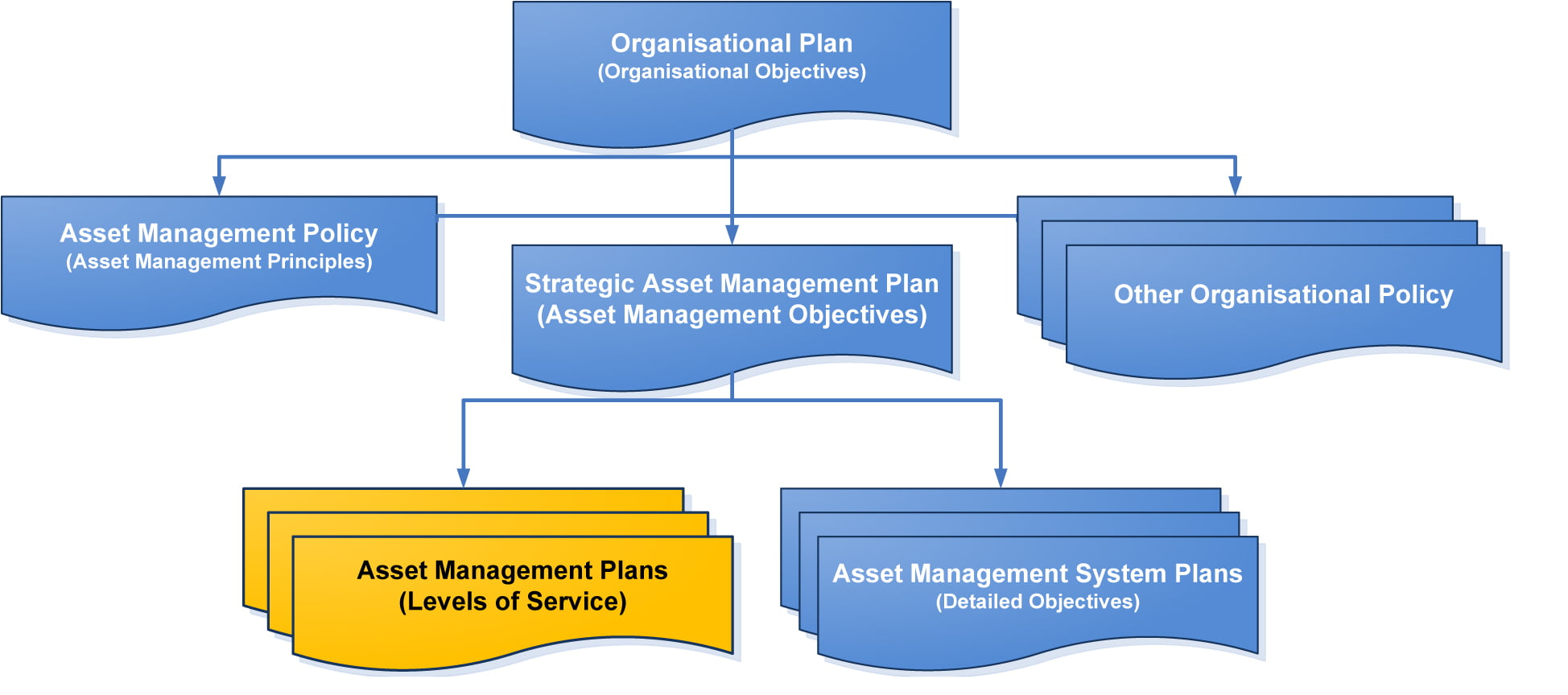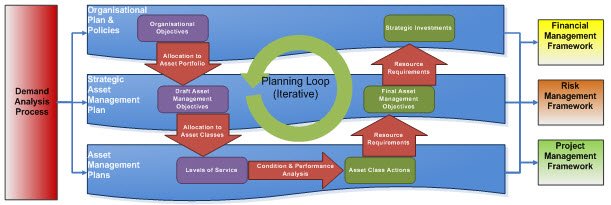In this article we discuss how to create a good asset management plan that will work for your organisation.
This is the fifth in a series of 13 articles on Implementing ISO 55000.
Articles in this series
As discussed in the earlier articles in this series, the Core Documents in an Asset Management system are the Asset Management Policy, Strategic Asset Management Plan (SAMP) and Asset Management Plans. We have covered the first two in other articles entitled How to write a good Asset Management Policy and Developing a Strategic Asset Management Plan. In this article we discuss the last – the detailed plans that describe the specific actions that must be taken to address the gaps between “what is” and “what should be”. As with the Strategic Asset Management Plan, there is no single “right way” to structure an Asset Management Plan, but we would like to share our thoughts on how to create a good one that will work for your organisation.
Document purpose
Let’s begin with the ISO 55000 definition of an Asset Management Plan:
Documented information that specifies the activities, resources and timescales required for an individual asset, or a grouping of assets, to achieve the organisation’s asset management objectives
This definition really captures the intent of the Asset Management Plan – writing down the things that need to be done to deliver the asset management objectives. As these objectives are derived from the organisational objectives (documented in the SAMP), it also emphasis the hierarchical nature of the core asset management documents as illustrated below:

We have indicated multiple plans in this diagram, but we should note that this is not a requirement of the definition, nor is it a requirement of ISO 55001:2014, which simply states:
The organization shall establish, document and maintain asset management plan(s) to achieve the asset management objectives. These asset management plan(s) shall be aligned with the asset management policy and the SAMP.
ISO 55001:2014
The standard does require documentation of decision criteria, processes and methods for managing assets, but very carefully does not require these to be part of an Asset Management Plan, even in the guidance in ISO 55002:2014. The guidance does, however, emphasise the need for an iterative planning process that will allow the organisation to balance its objectives with its available resources.
Taking all of this together, Asset Management Plans need to capture the lower level outcome of a comprehensive Asset Management planning process that is integrated with other organisational planning activities (in fact, this integration is an additional requirement of ISO 55001:2014) Without going into excessive detail, an ISO 55001 compliant planning process is illustrated below:

We see here how an iterative planning process will generate Asset Management Objectives that are aligned with the organisational objectives, informed by demand information (i.e. stakeholder wants and needs) and consistent with the condition, performance and capability of both the asset portfolio and the Asset Management system. These Asset Management Objectives must then be further broken down into detailed objectives applicable to specific assets or asset classes – commonly known as “levels of service”. Detailed information on the current condition and performance of the assets can then be used to identify gaps and establish actions to close them. These then roll up into coordinated projects across multiple asset classes and eventually into strategic programs across the organisation. At each stage, the resources required are compared with the resources available and iteration is undertaken to balance these. The final outputs will be delivered and tracked through other organisational frameworks such as budgeting, risk management and project management.
The key take-away from this discussion is that the Asset Management Plans are about communication. The planning process establishes what needs to be done to deliver the organisation’s objectives and the job of the plans is to communicate these requirements. In order to achieve it, the plans communicate from the asset managers (who conducted the planning) to:
- Internal staff (who need to complete the actions)
- Management (who need to provide the resources)
- Other Asset Managers (who need to know what performance to expect from this asset class)
- Other specialists (such as Human Resources or Learning and Development, who need to know what is expected of them)
The success of an Asset Management Plan should therefore be judged on its performance in these key roles and this allows us to define recommended content for a “good” Asset Management Plan as well as a recommended structure for an organisation’s suite of plans.
Recommended content
In order to deliver on its role as a communication tool, an Asset Management Plan must clearly be read and understood. To this end, we recommend a focus on the following three points with regards to the content of an asset management plan:
- Keep it short – everybody is busy and long plans simply don’t get read. Short plans are also much easier to maintain.
- Make it visual -tables and graphs can convey significantly more information than the equivalent space in words. They also break up the document, making it easier to read.
- Use references – by referencing other plans and data sources, the information is available for those that need it without cluttering up the plan for those who don’t. It also avoids issues with discrepancies between the different data sources that could lead to incorrect decisions and allows for each document/reference to be reviewed and updated on a timescale appropriate to its content.
We have found the following format useful in this regard:
- Asset Class information – a description of the scope of the particular plan, including the criticality and value of the assets and any interdependencies with other assets for the delivery of that value. For example, customer facing assets such as trains are often dependent on a large number of other Asset Classes (track, stations, signals, and so on). Changes in these other assets can have a significant impact on delivery of value if not well considered.
- Owners and Stakeholders – a list of roles and responsibilities relevant to the Asset Class(es) covered by the plan. This supports interaction between these stakeholders and appropriate distribution of the plan.
- Current and Desired Levels of Service – the Asset Management objectives specific to the content of the plan. These typically consist of a level of service statement supported by one or more performance measures with appropriate targets; for example, “Best in class reliability”, supported by a Mean Time Between Failure measure with a target of 1000 hours. Historic performance against the target and anticipated future changes in the target should be shown as these are indicators of gaps to be closed. This content is ideal for presentation in tables or graphs.
- Life Limiting Factors – a description of the key factors expected to drive the equipment out of service – e.g. fatigue, cost, obsolescence or demand changes. This content recognises that asset lives from acquisition are merely estimates used to justify the expenditure and that the true disposal point requires more careful tracking.
- Health, Safety and Environment – a description of any issues in these areas affecting the management of the asset. For example, this area might record a known change in legislation requiring the existing fleet to be retired before a specified date.
- Life Cycle Strategies – this section describes the approach to each phase of the asset’s life cycle and any known issues. It would typically reference detailed content such as the maintenance program, basis of design documentation, statement of operating intent or similar information. It would, however, identify issues with these documents, such as a recent change in operations that is outside the original strategy.
- Budget – a summary of the detailed budget showing the required and allocated resources for management of this asset, divided into segments appropriate to the organisation (e.g. sustaining capital, expansion capital and so on).
- Risks – a summary of the key asset management risks (not the entire risk register – though this might be referenced) that currently affect the asset.
- Actions – the list of prioritised and resourced actions to address the gaps. Examples of actions might include:
- Acquisition of additional assets to meet increasing demand or to replace old assets
- Disposal of old assets to meet declining demand or control risks associated with failure
- Application of Reliability Centered Maintenance techniques to reduce maintenance costs or to improve reliability
- Modification of assets to expand their functionality or increase reliability
- An Operator Driven Reliability program to reduce failures associated with operator error or misuse
As can be seen, this structure “tells the story” of the asset, with the final actions building from the issues identified in each section. We suggest that you aim for no more than 6-8 pages of content per asset class, bearing in mind that the audience for the document is not the technical experts in the asset – they already know (or should know!) what is required.
To assist you in putting together your Asset Management Plan, we have created an Asset Management Plan template, with guidance notes, that you can download from here.
Recommended structure
We have already discussed how there is no one “right way” to structure your asset management plans. There are, however, some broad classes that you might consider, and these are discussed in this section.
The simplest case is for discipline-led organisations. Here, the organisation has a strong central technical group broken into “disciplines” with clearly defined responsibilities for specific areas of the asset portfolio (for example, many organisations recognise structural, mechanical and electrical disciplines). In this case, it is generally sensible for each discipline to maintain one or more Asset Management Plans, each covering a specific Asset Class. Risks associated with this approach include a prioritisation of technical requirements over business objectives, including inadequate interfaces between the disciplines and poor overall prioritisation of activities. These can be addressed by a strong SAMP process to force cross-functional collaboration.
Another option is a single Asset Management Plan covering the entire asset portfolio. This minimises the effort required in the preparation and maintenance of the plan, and is therefore suited to organisations with simple asset portfolios or minimal Asset Management resources. The risk is, naturally, that the single plan does not provide enough resolution to identify key asset management issues lurking in the detailed performance information for the assets.
Our final option is a zone-led approach. Here, the organisation is divided into operational regions or zones that are largely independent. If there is limited central technical support, it makes sense for each zone manager to run their own Asset Management Plan(s), even where they operate similar assets. In this case, the risk is generally around inconsistent approaches to the same Asset Class, resulting in sub-optimal performance. This can be offset by establishing exchange forums to ensure differences in practice are discussed and best practice is shared across the organisation.
You may, of course, utilise different structures for your Asset Management Plan. For example, you may operate a zone structure, but allocate specific Asset Classes to each zone manager to conduct planning. If this works for you, then we would be delighted to hear about your experience and share it with others. Ultimately, the test of the Asset Management Plans must be the effectiveness of the organisation in achieving its Asset Management Objectives.
Good luck and happy planning!
Looking for further training in ISO 55001 certification?
We offer a range of asset management courses, some of which specialise in ISO 55001 deliverables. If you are interested in reading more about our courses, you can do so by following the links below.
-
Product on sale
 Implementing an ISO 55001 Compliant Asset Management SystemOriginal price was: $2,275.00.$2,047.50Current price is: $2,047.50.
Implementing an ISO 55001 Compliant Asset Management SystemOriginal price was: $2,275.00.$2,047.50Current price is: $2,047.50. -
Product on sale
 Asset Management Foundation AwardOriginal price was: $1,195.00.$1,075.50Current price is: $1,075.50.
Asset Management Foundation AwardOriginal price was: $1,195.00.$1,075.50Current price is: $1,075.50.
[1] ISO 55000:2014 – Asset management – Overview, principles and terminology, p. 14
[2] ISO 55001:2014 – Asset management – Management systems – Requirements, p. 4
[3] ISO 55002:2015 – Asset Management – Management systems – Guidelines for the application of ISO 55001, pp. 10-12
[4] ISO 55001, p. 4


